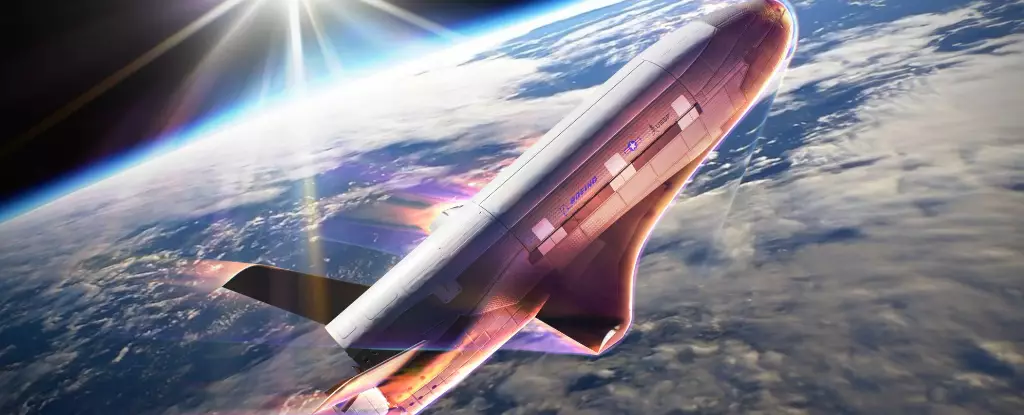The X-37B Orbital Test Vehicle (OTV) stands as a symbol of both advanced military technology and the complexities of modern space exploration. Designed and constructed by Boeing, this reusable spaceplane has intrigued military experts, scientists, and space enthusiasts alike since its first flight in April 2010. This unmanned, robotic vehicle is operated by the United States Space Force (USSF) and is primarily focused on testing technologies and conducting experiments in Low-Earth Orbit (LEO) – a region that stretches from approximately 240 to 800 kilometers (150 to 500 miles) above Earth.
On December 29, 2023, the X-37B commenced its seventh mission, also known as OTV-7. This mission is particularly notable as it delves deep into the effects of space radiation on various materials and explores advanced Space Domain Awareness (SDA) technologies. Among the proposed innovative maneuvers of this mission is the implementation of aerobraking, a technique that enables the spacecraft to skim through Earth’s upper atmosphere, allowing it to decrease its orbital speed and altitude while conserving fuel. This strategy not only showcases the vehicle’s cutting-edge capabilities but also raises questions about its potential for evading detection from ground-based monitoring systems.
Aerobraking is a well-established technique, famously used in past mission profiles, including the Mars Global Surveyor and more recently, the Mars Reconnaissance Orbiter. However, the X-37B’s undertaking of such a maneuver is unprecedented in its missions and adds a new layer of complexity and operational prowess. As Secretary of the Air Force Frank Kendall described, this groundbreaking maneuver highlights USSF’s commitment to innovative strategies in national security missions, underscoring the importance of maintaining an edge in the increasingly contested domain of outer space.
Despite its advanced mission parameters, the X-37B is still cloaked in a veil of secrecy. The USSF has intentionally kept details about the vehicle’s capabilities and operational goals under wraps. Nonetheless, insights from military officials offer some understanding of its strategic importance. For instance, during the Aspen Security Forum in 2019, former U.S. Air Force Secretary Heather Wilson shed light on the X-37B’s orbiting capabilities. By executing a unique elliptical orbital path, the spacecraft can obscure its movements from adversaries—an operational feature that has reportedly frustrated and complicated tracking efforts by foreign powers.
Astrophysicist Jonathan McDowell further elaborated on these capabilities, suggesting that the X-37B’s ability to ascend and descend through atmospheric layers allows it to alter its predictability. Any adjustments in timing regarding its next appearance can require adversaries to recalibrate their algorithms continually, essentially creating a “moving target” that complicates surveillance efforts. This element of unexpected maneuverability may serve as a powerful tool in modern military strategy, reinforcing deterrence against possible threats from nations keen on countering U.S. space initiatives.
While national security remains a major driver of the X-37B missions, scientific exploration also plays a pivotal role. Among the experiments conducted during OTV-7 is the “Seeds-2” experiment, which investigates the radiation impacts on plant seeds provided by NASA. Such investigations could pave the way for future agricultural endeavors in space, crucial as humanity contemplates longer missions to distant celestial bodies. Additionally, the X-37B’s maneuver involving the deliberate ejection of its service module components demonstrates an adherence to established standards regarding space debris mitigation, highlighting the importance of responsible space operations in an era where orbital congestion poses significant challenges.
As the X-37B approaches the completion of its aerobraking maneuver, it will transition back to its series of tests and experiments before concluding the mission. The implications of its results could have far-reaching impacts, not just for military applications but also for the broader scope of human endeavors in space exploration.
The X-37B’s ongoing operations signal an evolving paradigm in space strategy, blending defense with exploration and pushing boundaries in our understanding of outer space. With each mission, the vehicle not only reinforces the United States’ capabilities in space but also poses serious questions for geopolitical considerations in a landscape that becomes ever more competitive. The lessons learned from the X-37B may well serve to inform future designs and operational strategies, continuing the tradition of innovation that signifies the intricate relationship between national security and space exploration. As space becomes the next theater of military and scientific engagement, the X-37B stands at the forefront, embodying the complexities of technological advancement and its implications for humanity.


Leave a Reply